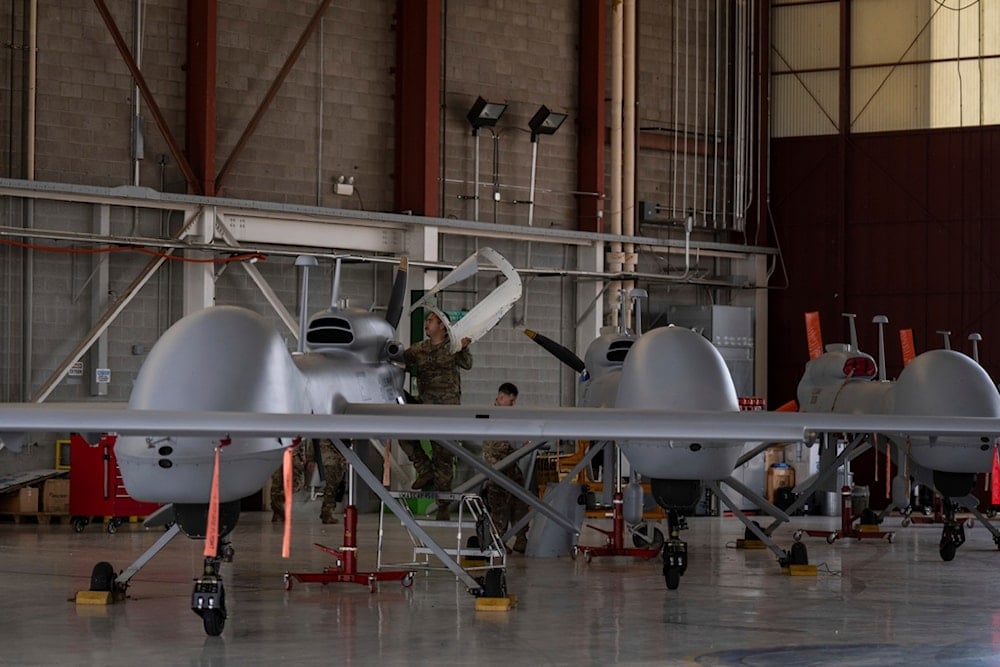Pentagon considers drone testing in Ukraine after failed Alaska trials
The Pentagon may test drones in Ukraine after flawed Alaska trials, as Zelensky and Trump agree on a potential $30B US deal for Ukrainian-made drones.
-

U.S. Army personnel perform maintenance on long-range drones at Fort Huachuca in Sierra Vista, Ariz., Tuesday, July 22, 2025 (AP)
The US Department of Defense is reportedly considering Ukraine as a live testing ground for drone technologies, following a series of underwhelming trials in Alaska earlier this summer, Defense News reported, citing sources within the Pentagon.
During June, five American defense companies tested new drone prototypes in Alaska to evaluate their resilience to GPS disruptions and assess their readiness for integration into military services. The results reportedly revealed several technological shortcomings, prompting Pentagon officials to explore more dynamic and hostile environments for future tests.
“There’s no better place in the world [than Ukraine] to test these systems,” said Trent Emeneker of the Defense Innovation Unit (DIU), as quoted by Defense News. He stressed the need to embed engineers directly with warfighters and to constantly test in real-world conditions if the US military is to keep pace with evolving threats.
Political complications slow deployment
A DIU official noted that contested environments offer critical feedback for both the Pentagon and private defense firms. “Providing an opportunity for these companies to assess their products in a contested environment against a notional threat is really valuable,” the official said, adding that small commercial developers especially lack access to realistic testing grounds.
Despite the enthusiasm within the DIU, sending American defense startups to Ukraine poses significant political challenges. Since President Donald Trump’s return to office, relations between Washington and Kiev have grown strained, making official deployments increasingly difficult, according to the report.
The tension has complicated Pentagon efforts to deepen collaboration with Ukraine’s military industry, even as battlefield conditions there offer what officials see as an unmatched proving ground for next-generation unmanned systems.
Ukraine, US discuss $30 billion drone deal
The revelations come just as Ukrainian President Volodymyr Zelensky announced a preliminary agreement with President Trump on Friday involving the sale of Ukrainian-made drones to the US. The deal, reportedly valued between $10 and $30 billion, marks a significant pivot in the military-industrial relationship between the two nations, even amid diplomatic frictions.
While the Department of Defense has not commented publicly on either the proposed testing shift or the drone procurement deal, defense analysts say the move signals Washington's intensifying focus on drone warfare, and on maintaining technological superiority by pushing development in active war zones.
Zelensky has called on European allies to begin financing salaries for troops, as his government struggles with dwindling recruitment and growing war fatigue among the population, Bloomberg reported on Friday.
"Previously, Europeans refused to provide funding for the salaries of our military personnel, only for weapons," Zelensky said during a press conference in Kiev on Thursday. "Our service members themselves can be the weapon that protects everyone."
Allies decline to finance Ukraine
According to Bloomberg, raising military salaries would add significant pressure to Ukraine's already strained finances, while the government ran a budget deficit exceeding 20% of GDP last year due to heavy military expenditures and remains heavily reliant on foreign aid. But, as stated in the report, allies have so far declined to finance direct military costs like personnel compensation, focusing instead on weaponry and humanitarian assistance.
Kiev’s pitch comes despite pressure from the International Monetary Fund (IMF) to reduce its fiscal gap. The IMF currently provides a $16 billion loan program, while Ukrainian officials estimate that only half of the required $75 billion budget over the next two years has been secured from global donors.

 4 Min Read
4 Min Read









